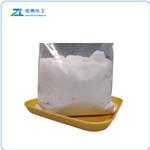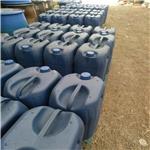Description
1-Tetradecanol is a kind of straight-chain saturated fatty alcohol. It is often used as an ingredient in cosmetics such as cold creams because of its emollient properties. It can also be used as the intermediate during the manufacturing of some organic compounds like surfactants. Some studies have shown that it can inhibit the endothelial activation and reduce tissue responsiveness to cytokines, having the potential to treat the periodontitis based on studies on rabbits. It is also employed for the fabrication of temperature-regulated drug release system based on phase-change materials.
References
Lehmler, Hans-Joachim, and Paul M. Bummer. "Behavior of 10-(perfluorohexyl)-decanol, a partially fluorinated analog of hexadecanol, at the air–water interface." Journal of fluorine chemistry 117.1 (2002): 17-22.
Hasturk, Hatice, et al. "1-Tetradecanol complex reduces progression of porphyromonas gingivalis–induced experimental periodontitis in rabbits." Journal of periodontology 78.5 (2007): 924-932.
Hasturk, H, et al. "1-Tetradecanol complex: therapeutic actions in experimental periodontitis." Journal of Periodontology 80.7(2009): 1103-13.
Choi, Sung-Wook, Yu Zhang, and Younan Xia. "A temperature-sensitive drug release system based on phase-change materials." Angewandte Chemie International Edition 49.43 (2010): 7904-7908.
Chemical Properties
Myristyl alcohol occurs as a white crystalline solid with a waxy
odor. Also reported as opaque leaflets or crystals from ethanol.
Chemical Properties
white low melting solid or flakes
Uses
myristyl alcohol is an emollient often used in hand creams, cold creams, and lotions to give them a smooth, velvety feel. Sources indicate it as being mildly comedogenic and potentially irritating.
Uses
1-Tetradecanol is used as an ingredient in cosmetics such as cold creams. It is an active intermediate in the chemical synthesis of sulfated alcohol. It is also employed in the fabrication of temperature-regulated drug release system based on phase-change materials. It plays a vital role in filling the hollow interiors of gold nanocages in the fabrication of new theranostic system, which has unique feature of photoacoustic imaging.
Uses
As emollient for cold creams, etc., also for making the sulfated alcohol whose sodium salt is applicable as a "wetter" in textiles.
Preparation
1-Tetradecanol is prepared from the head oil of the Sperm Whale via the acid and the ester.
Definition
ChEBI: 1-Tetradecanol is a long-chain fatty alcohol that is tetradecane in which one of the terminal methyl hydrogens is replaced by a hydroxy group It is a long-chain primary fatty alcohol, a fatty alcohol 14:0 and a primary alcohol.
Production Methods
Myristyl alcohol is found in spermaceti wax and sperm oil, and may
be synthesized by sodium reduction of fatty acid esters or the
reduction of fatty acids by lithium aluminum hydride. It can also be
formed from acetaldehyde and dimethylamine.
Synthesis Reference(s)
The Journal of Organic Chemistry, 35, p. 1210, 1970
DOI: 10.1021/jo00829a089
General Description
Colorless thick liquid (heated) with a faint alcohol odor. Solidifies and floats on water.
Air & Water Reactions
Insoluble in water.
Reactivity Profile
1-Tetradecanol is an alcohol. Flammable and/or toxic gases are generated by the combination of alcohols with alkali metals, nitrides, and strong reducing agents. They react with oxoacids and carboxylic acids to form esters plus water. Oxidizing agents convert them to aldehydes or ketones. Alcohols exhibit both weak acid and weak base behavior. They may initiate the polymerization of isocyanates and epoxides.
Health Hazard
Low toxicity. Overexposure causes some central nervous system depression. Prolonged skin contact causes skin irritation.
Flammability and Explosibility
Not classified
Pharmaceutical Applications
Myristyl alcohol is used in oral, parenteral, and topical pharmaceutical
formulations. It has been evaluated as a penetration
enhancer in melatonin transdermal patches in rats.
Myristyl alcohol has also been tested as a bilayer stabilizer in
niosome formulations containing ketorolac tromethamine,and
zidovudine.Niosomes containing myristyl alcohol showed a considerably slower release rate of ketorolac tromethamine than
those containing cholesterol.This was also observed with the
zidovudine formulation.
Safety
Myristyl alcohol is used in oral parenteral, and topical pharmaceutical
formulations. The pure form of myristyl alcohol is mildly toxic
by ingestion and may be carcinogenic; experimental tumorigenic
data are available.It is also a human skin irritant. In animal
studies of the skin permeation enhancement effect of saturated fatty
alcohols, myristyl alcohol exhibited a lower effect when compared
with decanol, undecanol, or lauryl alcohol but caused greater skin
irritation.A study investigating contact sensitization to myristyl
alcohol revealed that patch testing of myristyl alcohol 10%
petrolatum should not be carried out owing to observed irritant
effects; thus the use of a lower concentration of myristyl alcohol for
such tests (5% petrolatum) was recommended.Myristyl alcohol
has been associated with some reports of contact allergy.(8,9)A moderate-to-severe erythema and moderate edema are seen when
75 mg is applied to human skin intermittently in three doses over 72
hours.
LD
50(rabbit, skin): 7.1 g/kg
LD
50(rat, oral): 33.0 g/kg
storage
The bulk material should be stored in a well-closed container in a
cool, dry place.
Purification Methods
Crystallise the alcohol from aqueous EtOH. It has also been purified by zone melting. [Beilstein 1 IV 1864.]
Incompatibilities
Myristyl alcohol is combustible when exposed to heat or flame. It
can react with oxidizing materials. When heated to decomposition,
it emits acrid smoke and irritating fumes.
Regulatory Status
Included in the FDA Inactive Ingredients Database (oral tablet:
sustained-release; and topical formulations: cream, lotion, suspension).
Included in nonparenteral (topical cream) formulations
licensed in the UK.






